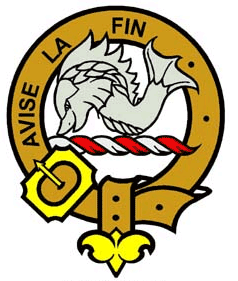Kennedy Clan
Kennedy Clan Crest: A dolphin.
Kennedy Clan Motto: Avise La Fin (Consider the end).
Kennedy Clan History:
This family originated from Ulster and are descended from Duncan of Carrick who lived in the 12th century. The first mention of the name is that of Gilbert Mac Kennedi who witnessed a Charter from the lands of Carric
in the reign of William the Lion.
John Kennedy of Dunure was in situ at Cassilis in 1360 and his son, Sir Gilbert, was a hostage for the release of David II from English custody three years earlier. Gilbert's son James married Princess Mary Stewart, daughter of Robert III, and their son, another Robert, was created Lord Kennedy in 1452. His brother James (1408-65) was Bishop of Dunkeld and Archbishop of St Andrews.
David, 3rd Lord Kennedy, was created Earl of Cassilis in 1502 and died at the Battle of Flodden eleven years later. The 2nd Earl was murdered by Sir Hugh Campbell of Loudon, Sheriff of Ayr, from whom he had unsuccessfully attempted to rescue James V. The 3rd Earl was poisoned in France on his return from the marriage of Mary Queen of Scots to the Dauphin in 1558.
The 6th Earl of Cassilis became Lord Justice General of Scotland and sat in Oliver Cromwell's House of Lords. Following the death of the 8th Earl without an heir, the Cassilis title and Kennedy Chiefship passed to Sir Thomas Kennedy of Culzean. He was succeeded by his brother David in 1775, and it was he who commissioned the architect Robert Adam to build the castle at Culzean.
When the 10th Earl died, the title and estates passed to his kinsman Captain Archibald Kennedy who had acquired estates in New Jersey and become a substantial landowner in New York. Unfortunately, the American War of Independence led to half of his properties being confiscated. The 12th Earl was created Marquess of Ailsa on the Coronation of William IV. In 1945, the 5th Marquess presented Culzean Castle to the National Trust for Scotland.
Branches of the Kennedy Family were also active in the north of Scotland. The Kennedys of Kermuck were Constables of Aberdeen in the 15th and 16th centuries. The Clan Ulric found in Lochaber are traditionally said to be descended from a Kennedy who fled to the Highlands following a warrant for his arrest.
Kate Kennedy, a niece of Bishop Kennedy of St Andrews is said to be the inspiration behind the student procession held annually at St Andrews University. Lt General Sir Clark Kennedy of Knockgray served in the Peninsular War and fought at the Battle of Waterloo in 1815. William Kennedy (1859-1918) became a distinguished military painter.
Places of Interest:
Castle Kennedy, Wigtown, Galloway. Built by the earls of Cassilis in 1607, but passed to the earls of Stair. Destroyed in 1716; replaced 1867 by Lochinch Castle which remains the seat of the Earl of Stair.
Culzean Castle, Ayrshire. A magnificent cliff-top mansion designed by Robert Adam for the 10th Earl of Cassilis on the site of an ancient Kennedy castle. It has been the seat of the Chief of the Kennedys since the 15th century and is now owned by the National Trust for Scotland.
Dunure Castle, near Culzean, Ayrshire. The 4th Earl of Cassilis is said to have roasted the Lay-Abbot of Crossraguel on a spit here in an attempt to make him surrender abbey lands in 1507. Today it is a ruin.
Maybole Castle, Maybole, Ayrshire. Chapel founded by John Kennedy of Dunure in 1371.
Surname distribution in Scotland: The Kennedy name is widespread throughout Scotland with particularly high concentrations of the name in Glasgow City, Dunbartonshire, Renfrewshire, Argyll and Bute, Ayrshire, Perth and Kinross (Perthshire and Kinross-shire), Lanarkshire and the Outer Hebrides (the main population centers being Lewis and Harris, North Uist, South Uist, Benbecula and Barra).
Associated family names (Septs): Carrick, Cassels, Cassilis, MacWalrick.
Clan Kennedy membership prints.

